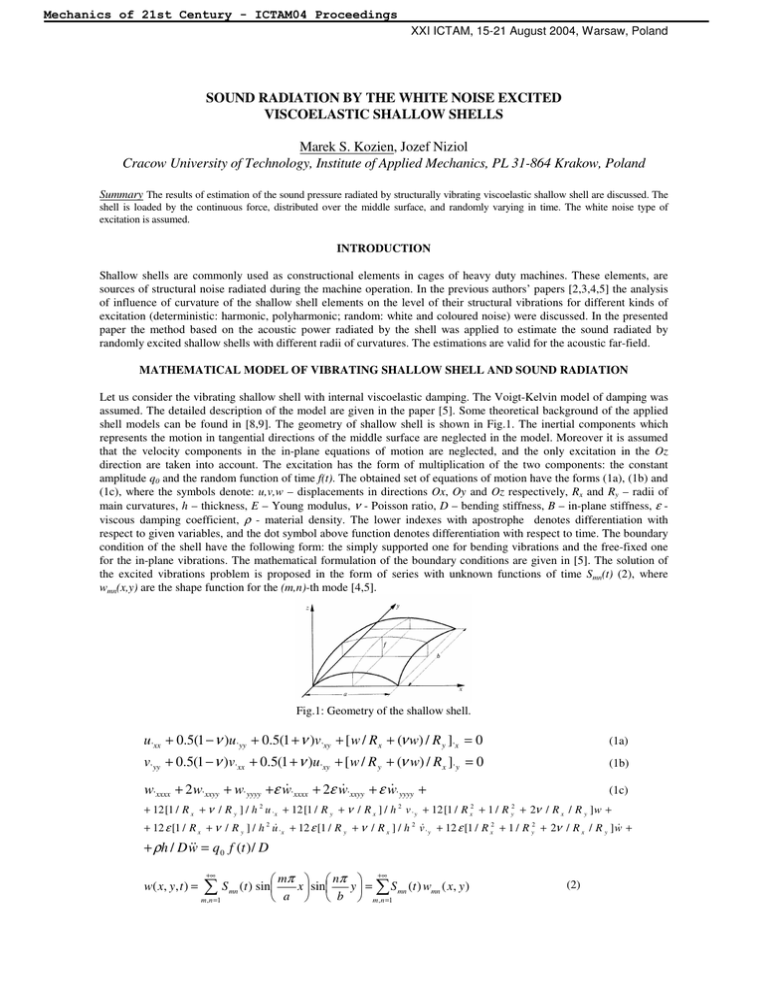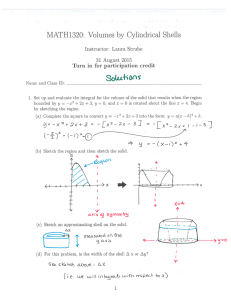Marek S. Kozien, Jozef Niziol VISCOELASTIC SHALLOW SHELLS
advertisement

Mechanics of 21st Century - ICTAM04 Proceedings XXI ICTAM, 15-21 August 2004, Warsaw, Poland SOUND RADIATION BY THE WHITE NOISE EXCITED VISCOELASTIC SHALLOW SHELLS Marek S. Kozien, Jozef Niziol Cracow University of Technology, Institute of Applied Mechanics, PL 31-864 Krakow, Poland Summary The results of estimation of the sound pressure radiated by structurally vibrating viscoelastic shallow shell are discussed. The shell is loaded by the continuous force, distributed over the middle surface, and randomly varying in time. The white noise type of excitation is assumed. INTRODUCTION Shallow shells are commonly used as constructional elements in cages of heavy duty machines. These elements, are sources of structural noise radiated during the machine operation. In the previous authors’ papers [2,3,4,5] the analysis of influence of curvature of the shallow shell elements on the level of their structural vibrations for different kinds of excitation (deterministic: harmonic, polyharmonic; random: white and coloured noise) were discussed. In the presented paper the method based on the acoustic power radiated by the shell was applied to estimate the sound radiated by randomly excited shallow shells with different radii of curvatures. The estimations are valid for the acoustic far-field. MATHEMATICAL MODEL OF VIBRATING SHALLOW SHELL AND SOUND RADIATION Let us consider the vibrating shallow shell with internal viscoelastic damping. The Voigt-Kelvin model of damping was assumed. The detailed description of the model are given in the paper [5]. Some theoretical background of the applied shell models can be found in [8,9]. The geometry of shallow shell is shown in Fig.1. The inertial components which represents the motion in tangential directions of the middle surface are neglected in the model. Moreover it is assumed that the velocity components in the in-plane equations of motion are neglected, and the only excitation in the Oz direction are taken into account. The excitation has the form of multiplication of the two components: the constant amplitude q0 and the random function of time f(t). The obtained set of equations of motion have the forms (1a), (1b) and (1c), where the symbols denote: u,v,w – displacements in directions Ox, Oy and Oz respectively, Rx and Ry – radii of main curvatures, h – thickness, E – Young modulus, ν - Poisson ratio, D – bending stiffness, B – in-plane stiffness, ε viscous damping coefficient, ρ - material density. The lower indexes with apostrophe denotes differentiation with respect to given variables, and the dot symbol above function denotes differentiation with respect to time. The boundary condition of the shell have the following form: the simply supported one for bending vibrations and the free-fixed one for the in-plane vibrations. The mathematical formulation of the boundary conditions are given in [5]. The solution of the excited vibrations problem is proposed in the form of series with unknown functions of time Smn(t) (2), where wmn(x,y) are the shape function for the (m,n)-th mode [4,5]. Fig.1: Geometry of the shallow shell. u 'xx + 0.5(1 − ν )u 'yy + 0.5(1 + ν )v 'xy + [ w / R x + (ν w) / R y ] 'x = 0 (1a) v'yy + 0.5(1 − ν )v 'xx + 0.5(1 + ν )u 'xy + [ w / R y + (ν w) / R x ]'y = 0 (1b) w'xxxx + 2 w'xxyy + w'yyyy +ε w'xxxx + 2ε w'xxyy + ε w'yyyy + (1c) + 12 [1 / R x + ν / R y ] / h u 'x + 12 [1 / R y + ν / R x ] / h v 'y + 12 [1 / R + 1 / R 2 2 2 x 2 y + 2ν / R x / R y ] w + + 12 ε [1 / R x + ν / R y ] / h 2 u 'x + 12 ε [1 / R y + ν / R x ] / h 2 v 'y + 12 ε [1 / R x2 + 1 / R y2 + 2ν / R x / R y ] w + + ρh / D w = q 0 f (t ) / D w( x, y , t ) = +∞ m , n =1 S mn (t ) sin +∞ mπ nπ x sin y = S mn (t ) wmn ( x, y ) a b m , n =1 (2) Mechanics of 21st Century - ICTAM04 Proceedings XXI ICTAM, 15-21 August 2004, Warsaw, Poland The correlation function of the process w(x,y,t) takes the form (3). After suitable averaging over a groups of realizations, and assuming that random function f(t) is the white noise type one, the dispersion of shell displacements can be written in the form (6) [5], where hij(t) are the transfer functions defined in [5] as a functions of eigenfrequencies and nondimensional modal damping coefficients. The theoretical background of the random analysis can be found in [7]. K ww (t1 , t 2 ) = +∞ +∞ wmn ( x, y ) S mn (t1 ) − ∞− ∞ σ w2 ( x, y, t ) = 2 256 z π 4 2 0 ρ h 2 +∞ 2 m , n =1, 3, +∞ w jk ( x, y ) S mn (t 2 ) p ( z1 , z 2 ; t1 , t 2 ) dz1dz 2 (3) j , k =1 wmn ( x, y ) mn w jk ( x, y ) +∞ jk j , k =1, 3, t (4) 1τ hmn (t − τ 1 ) dτ 1 h jk (t − τ 2 ) δ (τ 1 − τ 2 ) dτ 2 0 0 Based on the knowledge of the dispersion of displacements in Oz direction, the dispersion of the sound pressure level radiated in chosen control point in acoustic medium is estimated by the analysis of the sound power radiated by vibrating panel. One the one hand the acoustic sound power can be estimated based on the simplified formula (5) [1,6], and on the other one, the pressure for the far-field acoustic analysis can be estimated based on the formula (6) [6]. The applied symbols denote: <V2> - squared normal velocity averaged over the shell surface, ρ0 – density of the acoustic medium, c – speed of sound in acoustic medium, S - area of the shell, S* - area of the hemisphere with radius equal to approximate distance of the control point from the radiating panel, W – sound power radiated by the shell, σrad – radiation efficiency coefficient, pAVG – averaged sound pressure. W = σ red ρ c S < V 2 > (5) ρ cW = p (6) 2 AVG S ∗ NUMERICAL EXAMPLE Let us consider the shallow shell in the form of elliptical paraboloid made of steel, whose middle surface has the form (7). Their projection on the xy plane has the form of a square a=b=1 m. The thickness is h=0.002 m, and the damping coefficient is equal ε=0.001. The detailed values of geometrical and material parameters are the same like in [4,5]. The amplitude of excitation is equal to q0=1 N/m2. The estimated values of the pressure dispersion levels in the control point distanced 3 m over the centre of the middle surface, for different values of deflection f are given in Table 1. z ( x, y ) = f 1 − (7) ( 2 x − a ) 2 ( 2 y − b) 2 − 2a 2 2b 2 Table 1: Values of the pressure dispersion level in the control point. f [m] σ 2 p [dB] 0 0.01 0.02 0.05 0.2 70.5 49.0 38.1 24.0 0.9 CONCLUSIONS The results of analysis show an important influence of the shallow shell radii of middle surface curvatures on dispersion of the pressure in chosen control point in the acoustic surrounding medium. References [1] Beranek L. (Ed.), Noise and Vibration Control. Institute of Noise Control Engineering, Washington DC, 1988. [2] Kozien M., Niziol J.: Analysis of the Value of Normal Surface Velocity for the Vibrating Shallow Shell. Technical Bulletin of the Cracow University of Technology – Mechanics, 4-M: 1-18, 1993 (in Polish). [3] Kozien M., Niziol J.: Reduction of the Value of Normal Velocity for Vibrations of the Glass of Heavy Duty Machine TD20E – the Theoretical Analysis. Technical Papers of Rzeszow University of Technology, 117, Mechanics, 38: 71-78, 1993 (in Polish). [4] Kozien M.S., Niziol J., Random Excitex Vibrations of Viscoelastic Shallow Shells. Proceedings of the Fifth Workshop: Active Methods of Vibration and Noise Control, Krakow-Krynica, 225-232, 2001 (in Polish). [5] Niziol J., Kozien M.S.: White Noise Excited Vibrations of Viscoelastic Shallow Shells. J.Theoret.Appl.Mech., 2, 38: 351-366, 2000. [6] Panuszka R.: Research on the Sound Radiated by Circular Plate. Bulletin of the Academy of Mining and Metallurgy- Mechanics, 1, 1: 125-145, 1982 (in Polish). [7] Piszczek K., Niziol J.: Random Vibration of Mechanical System. PWN Warszawa – Ellis Horwood Ltd. Chichester, 1986. [8] Waszczyszyn Z.: Mechanics of Buildings. Computer Formulation. Vol.3, Arkady, Warszawa, 1995 (in Polish). [9] Xia Z.Q., Lukasiewicz S.: On Internal Resonance of Sandwich Cyllindrical Panels Under Periodic Loadings. In: Epstein M. (Ed.): A World of Shells. Festschrift In Honour of Peter G.Glockner on the Occasion of his Retitement from Teaching. The University of Calgary, Calgary, 201-225, 1995. << session << start



